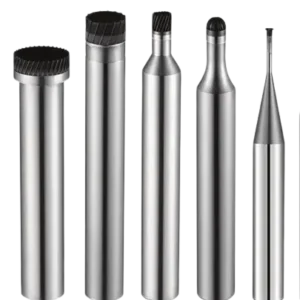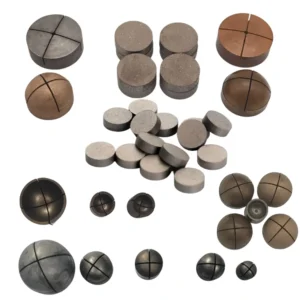Diamond Band Saw
Efficient Cutting: Fast, high-performance cuts on hard, brittle materials.
Flexible Design: Spring steel band with diamond coating, bends for complex cuts.
Durable: Long tool life due to wear-resistant diamond abrasives.
Versatile: Used in stone, ceramics, glass, and metal industries.
Customizable: Available in various thicknesses, tooth shapes, and coatings.
Description
Diamond Band Saw: Precision Cutting for Brittle Materials
A diamond band saw is a highly efficient diamond cutting tool, resembling a woodworking band saw used for cutting wooden boards. However, the key difference lies in the diamond band saw’s cutting edge, which consists of diamond particles bonded onto a steel band. The two ends of the diamond band saw are welded together to form a continuous loop, hence the name “band saw.” It is specifically designed for straight and curved cutting of brittle materials. Diamond band saws are generally thin (with a thickness of 1.0~2.0 mm) and long (ranging from 5 to 8 meters).
Structural Characteristics of Diamond Band Saw Blade
Base Material: The core of the diamond band saw blade is a high-quality spring steel band, which provides sufficient flexibility and strength. This allows it to rotate and bend like a belt while maintaining cutting stability.
Diamond Teeth: Diamond abrasive particles are bonded to the steel band using different bonding agents, forming sharp cutting teeth. The teeth can be classified into various shapes and sizes, such as continuous teeth, Great Wall teeth, semi-circular teeth, and rhombus teeth, to efficiently cut a variety of hard and brittle materials. Cast Grind Solutions offers customization diamond band saw options in terms of length, width, thickness, and tooth shape to meet the specific cutting needs of different industries.

Closed Loop Structure: The two ends of the steel band are welded together to form a continuous closed-loop structure, enabling unidirectional, high-speed rotation under the drive of the driving wheel.
Working Principle of Diamond Band Saw Blades
The diamond band saw blade operates by driving the main wheel with an electric motor, which propels the band saw around a passive wheel, achieving unidirectional cyclic high-speed movement. The material to be cut moves in a reciprocating linear motion to achieve the desired cutting results. To ensure precise and stable operation of the diamond band saw blades, guiding plates are typically installed on both sides of the diamond band saw above and below the worktable. Additionally, coolant or water cooling is applied to the cutting area and the band saw blades to maintain stability during the cutting process.
Performance Advantages of Diamond Band Saw Blades
High Efficiency Cutting: Diamond tip band saw blades offer exceptional cutting speeds, reaching hundreds of meters per minute, making them significantly faster than traditional reciprocating or wire saws.
Superior Cutting Surface: The cutting surface achieved by diamond coated band saws is smooth and precise, with narrow kerfs that save raw material compared to conventional sawing methods.
Exceptional Durability: The diamond teeth maintain their sharpness and cutting performance for extended periods, reducing downtime and replacement costs.
Flexibility: The flexible steel band allows for complex shape cutting and adapts to different workpiece geometries.

Technical Specifications
Electroplated Diamond Band Saw
An electroplated diamond band saw is an advanced cutting tool that uses a high-quality hardened steel band. The electroplating process securely and uniformly distributes premium diamond abrasive particles on the side of the steel band teeth, forming different tooth shapes based on specific application requirements.
Advantages of Electroplated Diamond Edge Saws:
High Cutting Efficiency: Electroplated diamond tipped band saw blades feature a unique linear structure that allows fast cutting of metal and non-metal materials.
Superior Wear Resistance: Since diamond abrasives are securely embedded in the plating layer, the diamond tipped band saw offers excellent wear resistance, withstanding higher cutting forces and longer operational times.
Precision Cutting: Electroplated diamond band saws provide narrow, uniform cuts with minimal warping, meeting the high precision demands of industries such as electronics and medical device manufacturing.
Wide Applicability: Suitable for cutting materials such as single-crystal silicon, polycrystalline silicon, graphite, ceramics, marble, and granite.
Brazed Diamond Band Saw
A brazed diamond band saw consists of three main components: the steel substrate, diamond particles, and a metal bonding layer. The steel substrate, typically made from high-strength steel, provides structural support. Diamond particles serve as the cutting edge, offering unparalleled hardness, while the metal bonding layer holds the diamonds firmly in place through brazing.
Characteristics of Brazed Diamond Band Saw:
High Grinding Efficiency: The high exposure rate of diamond particles and their strong bond to the substrate result in excellent grinding efficiency.
Extended Lifespan: The single-layer brazed structure ensures that new cutting surfaces are exposed gradually, prolonging the blade’s lifespan.
Clogging Resistance: The uniform distribution and high exposure of diamond particles prevent clogging, maintaining consistent cutting performance.
Wide Application Range: Ideal for cutting various hard and brittle materials, including stone, ceramics, and concrete.

Part of Cast Grind Solutions Diamond Band Saw Parameters
| Edge Thickness(mm) | Band Saw Core Thickness(mm) | Band Width(mm) | Total Length(mm) | Diamond Grit Size(um) | Teeth Shape |
| 0.65 | 0.3 | 10-40 | 1200-5000 | 120/140 | continuous or non-continuous |
| 0.8 | 0.4 | 10-40 | 1200-5000 | 100/120 | continuous or non-continuous |
| 0.9 | 0.45 | 10-50 | 1200-5000 | 80/100 | continuous or non-continuous |
| 1 | 0.56 | 10-50 | 1200-5000 | 80/100 | continuous or non-continuous |
| 1.1 | 0.75 | 10-60 | 2000-10000 | 80/100 | continuous or non-continuous |
| 1.5-1.8 | 0.8 | 10-60 | 2000-10000 | 50/60 | continuous or non-continuous |
| 1.6-1.9 | 0.9 | 10-100 | 2000-10000 | 50/60 | continuous or non-continuous |
| 3 | 1.05 | 10-100 | 2000-12000 | 35/40 | continuous or non-continuous |
| 3.3 | 1.25 | 10-100 | 2000-12000 | 35/40 | continuous or non-continuous |
- Length of the diamond band saw
- Width of the band saw
- Base thickness of the band saw
- Thickness of the diamond coating
- Required diamond abrasive grain size
- Diamond Band Saw blade tooth profile

Features
Usage Precautions for Diamond Band Saw
- Before use, thoroughly inspect the diamond edge saw machine’s operational condition.
- Ensure that all guide wheels and driving wheels are parallel and functioning smoothly. Verify that coolant flow and guide wheel alignment are correct.
- Adjust the band saw tension appropriately to prevent breakage or deviation.
- Select appropriate feed speed and pressure based on the thickness and hardness of the material.
- For thin or delicate materials, a toothless saw is recommended, while toothed saws are better for thicker materials.
Diamond band saws, with their high efficiency, precision cutting capabilities, durability, and flexibility, have a wide range of applications in the processing of hard and brittle materials.Cast Grind Solutions offers tailored diamond band saw solutions, ensuring high-quality, efficient cutting for various industries.
How to Choose the Right Diamond Band Saw Blade
- Choosing the appropriate diamond edge blades depends on its dimensions, thickness, diamond grit size, and tooth shape, which all affect its applications. Some key considerations include:
- For cutting thin materials (less than 6mm), straight tooth diamond band saws should be used, while for thicker materials (greater than 6mm), a wavy tooth diamond edge saw is recommended.
- For curved cutting and delicate materials, straight tooth band saws are preferred.
- As the thickness of the material increases, the thickness of the diamond band saw and the size of the teeth should also increase.

Application
Application Areas of Diamond Band Saw
Diamond coated band saw blades are widely used in processing hard and brittle materials, including:
Stone Industry: Cutting marble, granite, and other stone products.
Ceramic Industry: Cutting ceramic tiles, ceramic plates, and other materials.
Glass Processing: Cutting various thicknesses of glass materials.
Non-ferrous Metals: Suitable for precision cutting of non-ferrous metals.
Woodworking: In specific applications requiring fine and precise cuts.








